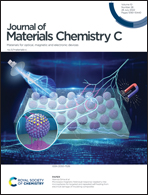Recent development of the fluorescence-based detection of volatile organic compounds: a mechanistic overview
Abstract
Clean air and water are indispensable components for a healthy life as well as fauna and flora to flourish. Volatile organic compounds (VOCs) are essential ingredients in several commonly used goods, however they are extremely toxic to public health and the environment even in very small quantities. Several detection methods, specifically fluorescence-based ones, have proved to be highly efficient in the qualitative as well as quantitative surveillance of VOCs in real-time, and have become advantageous considering their low cost and portability for on-site applications. Herein, we highlight the up-to-date development of fluorescent systems for the detection of VOCs on multiple platforms with special focus on their mechanistic exploration. Along with the classical fluorescent probes that emit only in their molecularly dispersed solution state, the advantage of aggregation-induced emission (AIE) phenomena has been rationalized for the development of turn-on VOC sensors. Precisely, along with the up-to-date development of fluorescence-based VOC sensors, this review explores the sensing mechanisms involved with fluorescent probes for toxic VOC detection, and could help in the future structural design of highly potent smart VOC sensors.



 Please wait while we load your content...
Please wait while we load your content...